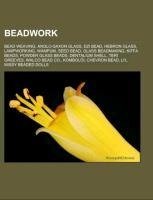
-
 Anglický jazyk
Anglický jazyk
Beadwork
Autor: Source: Wikipedia
Source: Wikipedia. Pages: 48. Chapters: Bead weaving, Anglo-Saxon glass, Dzi bead, Hebron glass, Lampworking, Wampum, Seed bead, Glass beadmaking, Kiffa beads, Powder glass beads, Dentalium shell, Teri Greeves, Walco Bead Co., Kombolói, Chevron bead, Li'l... Viac o knihe
Na objednávku, dodanie 2-4 týždne
15.93 €
bežná cena: 17.70 €
O knihe
Source: Wikipedia. Pages: 48. Chapters: Bead weaving, Anglo-Saxon glass, Dzi bead, Hebron glass, Lampworking, Wampum, Seed bead, Glass beadmaking, Kiffa beads, Powder glass beads, Dentalium shell, Teri Greeves, Walco Bead Co., Kombolói, Chevron bead, Li'l Missy Beaded Dolls, Juanita Growing Thunder Fogarty, Millefiori, Magatama, Murano beads, Bead knitting, Brookfield Craft Center, Love beads, Peranakan beaded slippers, Faturan, Bead stringing, Sequin, Peyote stitch, Bead crochet, Bead Game, Trade beads, Bead embroidery, Brick stitch, Heishe, The Bead Museum, Ultraviolet-sensitive bead, Aggry beads, Peranakan cut beads, Sewant, Bail, Big hole bead, Square stitch. Excerpt: Anglo-Saxon glass has been found across England during archaeological excavations of both settlement and cemetery sites. Glass in the Anglo-Saxon period was used in the manufacture of a range of objects including vessels, beads, windows and was even used in jewellery. In the 5 century AD with the Roman departure from Britain, there were also considerable changes in the usage of glass. Excavation of Romano-British sites have revealed plentiful amounts of glass but, in contrast, the amount recovered from 5 century and later Anglo-Saxon sites is minuscule. The majority of complete vessels and assemblages of beads come from the excavations of early Anglo-Saxon cemeteries, but a change in burial rites in the late 7 century affected the recovery of glass, as Christian Anglo-Saxons were buried with fewer grave goods, and glass is rarely found. From the late 7 century onwards, window glass is found more frequently. This is directly related to the introduction of Christianity and the construction of churches and monasteries. There are a few Anglo-Saxon ecclesiastical literary sources that mention the production and use of glass, although these relate to window glass used in ecclesiastical buildings. Glass was also used by the Anglo-Saxons in their jewellery, both as enamel or as cut glass insets. A clear distinction between glass making and glass working must be made. Glass making is the production of raw glass from the raw materials. Glass working on the other hand refers to the processing of raw glass or recycled glass to create new glass objects, although this may take place in the same location as glass making, it can also take place elsewhere. Glass consists of four principal components; a former, alkali flux, stabiliser and colourants/opacifiers. The main type of glass found in the Anglo-Saxon period is a soda-lime-silica glass, continuing the Roman tradition of producing glass. There is very little evidence for glass making from the raw materials in Roman Britain and
- Vydavateľstvo: Books LLC, Reference Series
- Rok vydania: 2013
- Formát: Paperback
- Rozmer: 246 x 189 mm
- Jazyk: Anglický jazyk
- ISBN: 9781156823316


 Nemecký jazyk
Nemecký jazyk 







